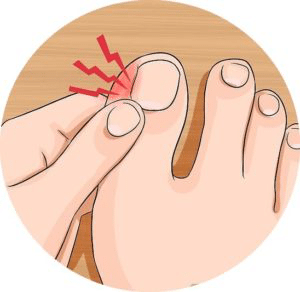Ingrown Toenails
Ingrown toenails are a common affliction, and it’s very likely that you have either suffered from them or seen one at some point in your life. But do you what causes them?
Ingrown nails are also known as onychocryptosis or unguis incarnates, and they are a condition in which the nail grows abnormally into the soft tissues around it, causing pain, swelling, bleeding and infection.

There are several factors which can increase the risk of developing ingrown toenails, such as:
- Shoes or even stockings which compress the toes.
- Cutting toenails too short, irregularly, or in a rounded shape.
- Trauma which affects the toe or nail.
- Activities which put excessive and/or repetitive pressure on the toenails, such as ballet, soccer, or kickboxing.
- Deficient foot hygiene, especially not keeping your feet dry. Sweat or humidity can cause tissues to soften and swell, which can cause ingrown toenails.
- Genetic predisposition.
- Age, since toenails thicken over time, making it more likely to develop ingrown toenails.
- Bacterial or fungal infections toenail infections.
Ingrown toenails can occur on any toe, but the toe most commonly affected is the big toe or hallux, and symptoms will vary depending on the severity of the condition. In the early stages of an ingrown toenail, you will experience:
- Pain that worsens when pressure is applied on the toe, even if it is slight. It is felt along one or both sides of the toenail.
- Swollen, red skin around the toenail.
If the nail ruptures the skin and the tissue becomes infected, symptoms can include:
- Pus or blood-tinged secretions oozing from the toe.
Patients who suffer from diabetes, peripheral vascular disease, or decreased sensitivity need to diligently care for their feet and treat ingrown toenails quickly and effectively, since people with these conditions have a harder time healing from injuries and could suffer greater complications, including the loss of the affected limb.
If you are suffering from an ingrown toenail, make sure to make an appointment with your podiatrist before attempting any home treatments. Your ingrown toenail expert will be able to assess the severity of your condition, whether the toe has become infected, and if that is the case, the treatment you should take and how far the infection has spread. Attempting to fix your ingrown toenail at home might lead to complications.
If the nail ruptures the skin and the tissue becomes infected, symptoms can include:
- Trimming your toenails straight across.
- Wearing footwear with a wide toe box to avoid placing excessive pressure on your toes.
- Soaking your feet in warm water a few times a day.
- Keeping your feet and shoes dry and clean.
There are two main types of ingrown nails Type 1: These are the early stages of irritation were the edge of the nail has become inflamed and swollen although the nail has yet to puncture the skin and there are no signs of infection. Type 2: Theses are the chronic ingrown nails were the nail has punctured into the skin and are often infected (blood, pus). Type 1 ingrown nails usually need minor conservative treatment. Type 2 ingrown nails often need minor nail surgery.
How is it affecting you?
- Irritating pain on the side of my toe
- Interfering with my exercise
- Interfering with me getting around at work
- Interfering with my chasing around with my kids
- Interfering with what shoes I want to wear!!
- I’m really feeling frustrated!! I don’t like being in PAIN!!!!!
No matter what the reason, you are our priority and we are committed to helping you get better.
1. Conservative Nail Treatment
Conservative treatment involves clearing of Stage 1 ingrown toenails. This is minor non-painful procedure that doesn’t involve local aesthetic. Stage 1 ingrown nails are classified when there is minor irritation or infection around the corner (tip) of the nail.
Benefits
- Immediate relief
- Quick and effective
- Pain Free (No needle, soft injection system)
2. Nail Surgery
Nail surgery is indicated when there is Stage 2 ingrown nail that hasn’t settled with conservative treatment. Stage 2 ingrown nails are classified when there is excessive irritation or infection along the entire edge of the nail.
Benefits
- Permanent removal of ingrown nail
- Fast recovery time
- Minimal or no discomfort post surgery
Never let the fear of pain stop you from getting the treatment you need. Call us today to make an appointment.
Request a Call Back
General Podiatry
- Corns & Callous
- Nail Cutting
- Plantar Warts
$15 Off First Visit
Only valid to New Patients to ModPod
Not to be used in conjunction with any other offer
Not to be used in conjunction with EPC programme
